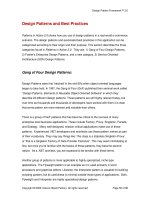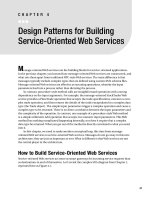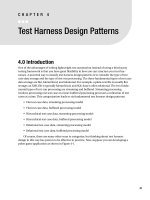oreilly csharp 3 design patterns
Bạn đang xem bản rút gọn của tài liệu. Xem và tải ngay bản đầy đủ của tài liệu tại đây (2.75 MB, 316 trang )
C# 3.0 Design Patterns
Other Microsoft .NET resources from O’Reilly
Related titles
.NET Books
Resource Center
C# 3.0 in a Nutshell
C# 3.0 Cookbook
Head First C#
Head First Design Patterns
Learning C# 2005
Programming C# 3.0
dotnet.oreilly.com is a complete catalog of O’Reilly’s books on
.NET and related technologies, including sample chapters and
code examples.
ONDotnet.com provides independent coverage of fundamental,
interoperable, and emerging Microsoft .NET programming and
web services technologies.
Conferences
O’Reilly & Associates bring diverse innovators together to nurture the ideas that spark revolutionary industries. We specialize
in documenting the latest tools and systems, translating the
innovator’s knowledge into useful skills for those in the
trenches. Visit conferences.oreilly.com for our upcoming events.
Safari Bookshelf (safari.oreilly.com) is the premier online reference library for programmers and IT professionals. Conduct
searches across more than 1,000 books. Subscribers can zero in
on answers to time-critical questions in a matter of seconds.
Read the books on your Bookshelf from cover to cover or simply flip to the page you need. Try it today for free.
C# 3.0 Design Patterns
Judith Bishop
Beijing • Cambridge • Farnham • Kưln • Paris • Sebastopol • Taipei • Tokyo
C# 3.0 Design Patterns
by Judith Bishop
Copyright © 2008 Judith Bishop. All rights reserved.
Printed in the United States of America.
Published by O’Reilly Media, Inc., 1005 Gravenstein Highway North, Sebastopol, CA 95472.
O’Reilly books may be purchased for educational, business, or sales promotional use. Online editions
are also available for most titles (safari.oreilly.com). For more information, contact our
corporate/institutional sales department: (800) 998-9938 or
Editor: John Osborn
Production Editor: Loranah Dimant
Copyeditor: Rachel Wheeler
Proofreader: Loranah Dimant
Indexer: John Bickelhaupt
Interior Designer: David Futato
Cover Illustrator: Karen Montgomery
Illustrator: Jessamyn Read
Printing History:
December 2007:
First Edition.
Nutshell Handbook, the Nutshell Handbook logo, and the O’Reilly logo are registered trademarks of
O’Reilly Media, Inc. C# 3.0 Design Patterns, the image of a greylag goose, and related trade dress are
trademarks of O’Reilly Media, Inc.
Many of the designations used by manufacturers and sellers to distinguish their products are claimed as
trademarks. Where those designations appear in this book, and O’Reilly Media, Inc. was aware of a
trademark claim, the designations have been printed in caps or initial caps.
While every precaution has been taken in the preparation of this book, the publisher and author assume
no responsibility for errors or omissions, or for damages resulting from the use of the information
contained herein.
This book uses RepKover™, a durable and flexible lay-flat binding.
ISBN 10: 0-596-52773-X
ISBN 13: 978-0-596-52773-0
[M]
In memory of my beloved father,
Tom Mullins (1920–2007).
Table of Contents
Foreword . . . . . . . . . . . . . . . . . . . . . . . . . . . . . . . . . . . . . . . . . . . . . . . . . . . . . . . . . . . . . . . . xi
Preface . . . . . . . . . . . . . . . . . . . . . . . . . . . . . . . . . . . . . . . . . . . . . . . . . . . . . . . . . . . . . . . . xv
1. C# Meets Design Patterns . . . . . . . . . . . . . . . . . . . . . . . . . . . . . . . . . . . . . . . . . . . . 1
About Patterns
About UML
About C# 3.0
About the Examples
2
3
5
6
2. Structural Patterns: Decorator, Proxy, and Bridge . . . . . . . . . . . . . . . . . . . . . . . 8
Decorator Pattern
Proxy Pattern
Bridge Pattern
Example: OpenBook
Pattern Comparison
9
22
36
39
46
3. Structural Patterns: Composite and Flyweight . . . . . . . . . . . . . . . . . . . . . . . . . 49
Composite Pattern
Flyweight Pattern
Exercises
Pattern Comparison
49
61
72
72
4. Structural Patterns: Adapter and Faỗade . . . . . . . . . . . . . . . . . . . . . . . . . . . . . . 74
Adapter Pattern
Faỗade Pattern
Pattern Comparison
74
93
99
vii
5. Creational Patterns: Prototype, Factory Method, and Singleton . . . . . . . . 101
Prototype Pattern
Factory Method Pattern
Singleton Pattern
Pattern Comparison
101
110
115
120
6. Creational Patterns: Abstract Factory and Builder . . . . . . . . . . . . . . . . . . . . 122
Abstract Factory Pattern
Builder Pattern
Pattern Comparison
122
129
137
7. Behavioral Patterns: Strategy, State, and Template Method . . . . . . . . . . . 139
Strategy Pattern
State Pattern
Template Method Pattern
Pattern Comparison
139
148
158
162
8. Behavioral Patterns: Chain of Responsibility and Command . . . . . . . . . . . 164
Chain of Responsibility Pattern
Command Pattern
Pattern Comparison
164
175
186
9. Behavioral Patterns: Iterator, Mediator, and Observer . . . . . . . . . . . . . . . . . 188
Iterator Pattern
Mediator Pattern
Observer Pattern
Pattern Discussion and Comparison
188
200
210
217
10. Behavioral Patterns: Visitor, Interpreter, and Memento . . . . . . . . . . . . . . . 220
Visitor Pattern
Interpreter Pattern
Memento Pattern
Pattern Comparison
viii |
Table of Contents
220
233
242
252
11. The Future of Design Patterns . . . . . . . . . . . . . . . . . . . . . . . . . . . . . . . . . . . . . . 253
Summary of Patterns
A Future for Design Patterns
Concluding Remarks
253
256
258
Appendix . . . . . . . . . . . . . . . . . . . . . . . . . . . . . . . . . . . . . . . . . . . . . . . . . . . . . . . . . . . . . . 259
Bibliography . . . . . . . . . . . . . . . . . . . . . . . . . . . . . . . . . . . . . . . . . . . . . . . . . . . . . . . . . . . 283
Index . . . . . . . . . . . . . . . . . . . . . . . . . . . . . . . . . . . . . . . . . . . . . . . . . . . . . . . . . . . . . . . . . 285
Table of Contents |
ix
Foreword
1
When you’re faced with a problem to solve (and frankly, who isn’t these days?), the
basic strategy usually taken by we computer people is called “divide and conquer.” It
goes like this:
• Conceptualize the specific problem as a set of smaller sub-problems.
• Solve each smaller problem.
• Combine the results into a solution of the specific problem.
Reducing complex problems down to the level of twiddling the states of a few billion bits is what we do all day. But “divide and conquer” is not the only possible
strategy. We can also take a more generalist approach:
• Conceptualize the specific problem as a special case of a more general problem.
• Somehow solve the general problem.
• Adapt the solution of the general problem to the specific problem.
Design patterns are among the major tools in the toolboxes of those who espouse the
generalist approach. If you look at samples from a broad spectrum of software solutions, you will find that though the specifics may vary widely, there is often an
underlying structural similarity. (Searching a filesystem for a file with a particular
attribute is in some sense structurally similar to searching an annotated parse tree for
a symbol with a particular type.) Design patterns codify general solutions to common
problems.
The ultimate example of the generalist approach is of course the design and implementation of programming languages themselves. As problem solving tools go, it is
hard to get more general than a programming language like C#. When designing
new programming languages (or new versions of old programming languages), we
think about common problems that are faced every day by real developers and figure
out how to create a language which solves them in a general, aesthetically pleasing,
and powerful way that is broadly applicable.
xi
We want to embed the most useful and powerful abstractions so deeply into the language infrastructure that you barely even consciously register them as being there
anymore. Patterns like “local variable” or “procedure call” or “while loop” are so
much a part of the air we all breathe that we don’t even think of them as patterns
anymore.
Furthermore, we want to make a language in which patterns which are useful but perhaps not quite so fundamental are nevertheless relatively straightforward to implement
clearly and elegantly. A class in C# may be marked as “static,” or “abstract,” or
“sealed,” but not as “singleton.” That was a deliberate choice of the language designers. However, implementing a singleton class in C# is still relatively easy.
The gray zone in between “clearly foundational” and “occasionally useful” is where
the interesting design challenges lie. Our observations of design patterns used by
real-world developers in C# (and other languages) strongly drive the design process
for new versions.
Consider for example how you would implement an iterator pattern on a linked list
in C# 1.0. You would end up defining an enumerator class to represent a position in
the list containing a lot of boring boilerplate code (which impedes readability), and
the solution would not be very reusable. The notion of “enumerate a set of things” is
sufficiently applicable to a wide variety of problems that it met the bar for inclusion
as a first class language concept. In C# 2.0 with its yield return statement the compiler can generate all the boring code for you, and the generic type system makes iterating over a set of things typesafe no matter what the “things” are.
All of this is a long way to say just why it is that I am so very excited about Language
Integrated Query (LINQ) in C# 3.0. We believed that iterating over collections of
things was a great start, but that we could do so much more. Sorting, filtering, grouping, joining, projecting, and transforming data are also fundamental operations that
are useful in pretty much every domain. Whether you are writing a ray tracer, a compiler, an XML reader, or an online banking security system, odds are good that you
are going to need to manipulate collections of something in a rich way.
By moving these concepts out of domain-specific object models and into a generalpurpose programming language, we hopefully solve those more general problems.
We additionally hope, though, that by adding C# 3.0’s query expressions, lambda
expressions, extension methods, initializer expressions, expression trees, and so on
to the already rich set of C# 2.0 and 1.0 features, we make it easier to elegantly
implement all sorts of other useful design patterns.
xii
|
Foreword
And that is also why I am excited about this book. C# 3.0 Design Patterns brings the
frequently abstruse world of design patterns into sharp focus with pragmatic C# 3.0
implementations. I look forward to seeing where developers can go with these tools
and this language, and what useful patterns we can build into the infrastructures of
future languages.
—Eric Lippert
Senior Developer
C# Compiler Team
Seattle, Washington
November 30, 2007
Foreword
|
xiii
Preface
2
Why I Wrote This Book
In 2002, Microsoft Research hosted an international meeting in Cambridge, U.K., to
reveal its Rotor system, which would bring C# and .NET to non-Windows programmers. Once back home, writing software, papers, and a book on the topic, I came to
realize that we had witnessed the beginning of a real revolution in programming.
Since the advent of Java in 1996, programming had become platform-independent:
with Java byte-code, programs could run anywhere. This independence, however,
extended only to programs written in the Java language. .NET, on the other hand,
was language-independent: it allowed programs in different languages to interact,
but, up until that day, only on Windows.
In the ensuing five years, new platforms have come to support .NET (Mono, for
example) and new hardware has come to support Intel chips (on which Windows
runs). The result is that .NET now runs almost anywhere. Consequently, expertise in
C# programming is a very transportable skill to acquire. But C# keeps improving as
a language, and we are currently at the beginning of a new leap forward into C# 3.0,
which offers enormous benefits in terms of productivity and ease of programming.
Having already written an introductory C# text in 2003,* I realized that the benefits
of the new features announced now in 2007, four years later, would be felt at a much
more advanced level of software development. I wanted to write a second book that
introduced C# 3.0 to developers who already knew the basic language—but what
would be the formula that could introduce a language and address a reader’s needs
of precision, examples, and a heavy dose of reality?
Enter design patterns. Design patterns encapsulate common, accepted, and proven
ways of using language features together. They form a level of discourse at a higher
plane, and they exercise and promote good programming practices. However, there
is an element of unreality surrounding design patterns, and one gets the impression
* Judith Bishop and Nigel Horspool, C# Concisely (Boston, MA: Addison-Wesley, 2003).
xv
that they are more talked about than used. I wanted to change that and make design
patterns really accessible to ordinary programmers, using the best language for them:
C# 3.0. The result is this book.
Who This Book Is For
If you are a programmer who loves your code, for whom every line has a precise
meaning and every feature has a correct place, this book is for you. It will help you
with your primary job of making your code correct, elegant, extensible, and efficient. If you serve the business ends of your organization by focusing on the quality
of your code, you need a book like C# 3.0 Design Patterns. Knowledge about design
patterns is also a big step forward for those working up from low-level programmers
to software engineers and architects.
Through reading this book, you will acquire skills in:
• Programming design patterns
• Basic UML modeling notation for representing patterns
• Selecting patterns appropriate for given scenarios and comparing alternative
implementations
• Using advanced language features of C# 3.0 to realize patterns efficiently and
elegantly
Although not written as a textbook, C# 3.0 Design Patterns could fit in very well for
a mid-degree course on design patterns or advanced programming.
The diagrams and code for all the patterns and associated examples and case studies
in this book can be found on the book’s web site, />9780596527730.
What You Need to Know
This book is for programmers who know how to program in C# 1.0 or Java 1.4 and
who would like to move on to the more modern features of the latest language. All
the new features of C# 3.0, as well as many novel features from C# 2.0, are introduced by example and summarized in sidebars for easy reference. Thus, the book
serves as a programmers’ guide as well.
The book does not assume any acquaintance with design patterns. It covers the full
set of 23 patterns that were originally proposed in Erich Gamma, Richard Helm,
Ralph Johnson, and John Vlissides’s Design Patterns: Elements of Reusable ObjectOriented Software in 1994 and now form a common introductory base to the patterns that are emerging in many other domains (such as security, concurrency, and
architectural design). At the end of the book, the reader will have a thorough
grounding in design patterns as they are commonly understood.
xvi |
Preface
How This Book Is Organized
After the introduction in Chapter 1, the book takes a tour through the 23 core design
patterns. Each chapter discusses two or three patterns, chosen because they have
some common applicability and can be compared at the end of the chapter. The patterns are subdivided into three groups: structural, creational, and behavioral.
We begin with the structural patterns, studying the Decorator, Proxy, and Bridge
patterns in Chapter 2; the Composite and Flyweight patterns in Chapter 3; and the
Adapter and Faỗade patterns in Chapter 4. We then move on to the creational patterns, exploring the Prototype, Factory Method, and Singleton patterns in Chapter 5
and the Abstract Factory and Builder patterns in Chapter 6. The last four chapters
deal with the largest category, the behavioral patterns: Chapter 7 focuses on the
Strategy, State, and Template Method patterns; Chapter 8 on the Chain of Responsibility and Command patterns; Chapter 9 on the Iterator, Mediator, and Observer
patterns; and Chapter 10 on the Visitor, Interpreter, and Memento patterns.
Our discussion of each pattern will consist of the following parts:
Role
A short, high-level description of the pattern and what it is meant to achieve
Illustration
An example of where the pattern might be used in programming a modern computer system, illustrating a real-world context with a photo or diagram to help
you remember the pattern
Design
An identification of the interconnected players in the pattern and their roles,
explained in a UML diagram, with links back to the key players in the
illustration
Implementation
A stepwise refinement development of a short program that illustrates the pattern using the terms introduced in the “Design” section
Example
A second program that gives an example of the pattern, usually in terms of the
illustrative example, where the programming moves away from a strict adherence to the pattern terms
Use
A discussion of real-world scenarios where the pattern might be used, ending
with a table listing the conditions that would make its use applicable
Exercises
A list of exercises of differing degrees of difficulty designed to enhance your
understanding of the pattern under discussion
Preface |
xvii
At the end of each chapter you will find a comparison of the patterns discussed
therein and a discussion of how they fit in with those that have gone before.
The ordering of the patterns has been carefully chosen so as to represent a gradual
progression in C# 3.0 maturity. Implementing the earlier patterns in each section
requires very little that is not available in C# 1.0, while the later patterns are more
sophisticated in their implementation and take advantage of more advanced features
present in C# 3.0. This approach allows new features to be introduced inline, as they
become relevant, rather than all at once at the start or end of the text.
This book is not intended to be a reference guide to the whole of C# or even C# 3.0,
but rather to be a practical guide to using the most interesting features of the language. Although the emphasis is on developments in the most recent version, I also
pick out some features of C# 1.0 and 2.0 that I think are really useful but that are
not often employed in code. The list of C# features explicitly covered follows this
Preface.
Special features of this book include:
• Pictorial illustrations of patterns, to help you focus on the meaning of what each
pattern can accomplish in real life
• Quizzes that relate the illustrations to the UML diagrams
• Uncluttered “theory” code that can be adapted to many situations
• Tables that give guidance on when to choose a specific pattern
• Comparison tables for patterns that are similar, showing how they differ
• Lists of the advantages, disadvantages, and limitations of each pattern
• Challenges and exercises to help you take your knowledge further
What You Need to Use This Book
To run the programs in this book, you need:
• A computer that will run Windows XP or Vista. Compatible platforms are any
PC or Intel-based Mac with a virtual machine.
• Microsoft’s .NET Framework 3.5. As of October 2007, this version is still in Beta
2, but it is very stable now. It is available at />• A program editor or programming environment. Visual Studio 2008 is an ideal
companion to C# 3.0 programming, but it is not essential.
• The C# 3.0 reference documentation, available on the Microsoft web site (http://
msdn2.microsoft.com/vcsharp, 529 pages).
All the programs in this book were prepared on an iMac Intel Core 2 Duo running
Mac OS X 10.4 and 5 (Tiger and Leopard) and Windows XP on top of the Parallels
virtual machine. The editor used was SciTE.
xviii |
Preface
Finding What You Need
This book is intended to serve as a learning resource. In learning about C# 3.0 and
design patterns, there will be times when you will need to find a particular feature or
a related pattern. These tables are given in Chapter 11 for easy reference. The UML
class diagram notation is covered in Chapter 1. You will also find that there are a few
programs that, for space reasons, are not presented in full in the text. These are all
included in the Appendix.
Conventions Used in This Book
The following typographical conventions are used in this book:
Italic
Indicates new terms, URLs, and email addresses.
Constant width
Indicates code examples and excerpts, commands, options, variables, attributes,
functions, types, classes, namespaces, methods, properties, parameters, values,
objects, events, and XML tags.
Constant width bold
Used for emphasis or highlighting in code examples.
Constant width italic
Shows text that should be replaced with user-supplied values.
This icon signifies a tip, suggestion, or general note.
This icon indicates a warning or caution.
Using Code Examples
This book is here to help you get your job done. In general, you may use the code in
this book in your programs and documentation. You do not need to contact us for
permission unless you’re reproducing a significant portion of the code. For example,
writing a program that uses several chunks of code from this book does not require
permission. Selling or distributing a CD-ROM of examples from O’Reilly books does
require permission. Answering a question by citing this book and quoting example
code does not require permission. Incorporating a significant amount of example
code from this book into your product’s documentation does require permission.
Preface
| xix









